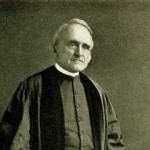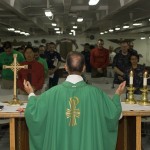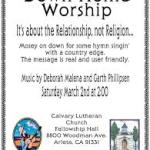§28. REGENERATION.
Justification and regeneration stand in the closest relation to each other. The terminology has not always been the same, but has been changed from time to time, while the subject matter concerned has always been fixed. We have already called attention to the fact that different presentations have been made by different theologians of our Church, and opinions are still divided, but everything depends on a good interpreter, i. e., if we understand the definition correctly, clarity and order will ensue. The Formula of Concord speaks of different definitions of regeneration.[1] We quote the following: “The word regeneration is sometimes understood in the sense that it includes both the forgiveness of sins, which is experienced for Christ’s sake alone, and renovation, which the Holy Spirit works in those that are justified by faith. At times it signifies the forgiveness of sins alone and the adoption as the sons of God. In the latter sense it is very often found in the Apology. As for example when it is stated: ‘Justification is regeneration.’ But Paul also makes a distinction between these words when he says in Titus 3:5: ‘According to his mercy he saved us through the washing of regeneration and renewing of the Holy Spirit.’ The word ‘vivifying’ (vivificatio) is therefore sometimes used to signify the forgiveness of sins. For since man is justified through faith, which the Holy Spirit alone works, it certainly is a regeneration, because man is changed from a child of wrath to a child of God.” From this it is evident that regeneration has been variously defined. Some have considered it late dicta (broad sense) others stricte dicta (narrow sense) and still others strictissime dicta (narrower sense). By regeneration late dicta is understood all the acts of grace or regeneration in the broad sense; stricte dicta denotes regeneration in the sense of new life and sonship; while strictissime dicta is equivalent to the gift of faith or donatio fidei.
1. The Definition of Regeneration.
Regeneration is the act of grace through which the converted sinner at the time of, in, with and through justification receives the new spiritual life, becomes a child of God and is renewed in heart.
The definition here given corresponds with the technical term regeneratio stricte dicta. The so-called late dicta is rarely used. The selection is, therefore, between stricte and strictissime dicta. According to both of these definitions regeneration is instantaneous like justification. Since conversion, as most generally defined, consists of contrition and faith, there is a difference in the conception of conversion and regeneration, the former being progressive and the latter instantaneous. A baptized child is regenerated, and an adult Christian may also be converted, depending upon whether or not he has fallen from grace and been restored. There has been a dispute among theologians as to whether such a converted and restored person is again regenerated. This question depends upon whether or not regeneration can be lost. If faith can be lost, it is self-evident that regeneration can be lost. This takes place when a fall occurs by self-conscious, premeditated and intentional sin. A real apostasy may not result, if repentance follows soon. Still it is a fall. It is not always easy, however, to distinguish between an intentional and an unintentional sin. It may be a case like the fall of Peter, where faith is not entirely extinguished. A righteous person may in a certain sense fall seven times and yet arise again. When a real fall occurs, man is in the same condition as the prodigal son. Before he returned, he was looked upon as dead, but when he returned and was restored, the father said: “This my son was dead and is alive again.” It is clear that a person cannot be regenerated and at the same time be dead in sins. We must be careful in using the analogy of human birth so that we do not identify a birth into the natural life with the experience of being born again in the kingdom of God. A spiritually dead person, who once lived spiritually, may be reborn in the kingdom of grace.
For the sake of clearness it is also of some importance to investigate or decide which definition of regeneration is the most Biblical. There is very little hope, if any, that theologians will agree on this question. Many will follow the old dogmatic view according to the definition regeneratio strictissime dicta or regeneration to faith. Just as many prefer regeneratio stricte dicta or regeneration by or through faith. Regeneration cannot exist before faith, and a person cannot be justified without faith. We are justified by faith. “Being therefore justified by faith, we have peace with God through our Lord Jesus Christ; through whom also we have had our access by faith into this grace wherein we stand” (Rom. 5: 1, 2) ; “The righteous shall live by faith” (Rom. 1: 17). Faith is receptive and apprehensive and manifests itself in confidence or trust. When the Lutheran Church rejects fides caritate formata (faith formed by love) and emphasizes the purely receptive character of faith, it seems that regeneration by faith is a clearer expression than regeneration to faith, although the latter term also presents the life in faith. The Bible teaches plainly that we are justified by faith. If we are justified by faith, we are also regenerated. It is clearly evident that regeneration cannot be the cause of justification. Justification as the objective act and fact is the causative factor. When the Holy Spirit works faith in the repenting sinner, that very moment God justifies him, and the subjective effect is regeneration. All three acts occur at the same time. But in order to have a logical and clear conception we must place justification before regeneration. A sinner could not be regenerated in the strict sense, if he were not justified. Justification is the great cause in the heart of God in heaven, and regeneration is the great effect by the Holy Spirit in the heart of man on earth.
According to the old Dogmaticians regeneration is the same as conversio transitiva (transitive conversion) and especially donatio fidei (the giving of faith). Hollazius defines as follows:[2] “Regeneratio is the act of grace through which the Holy Spirit endows the sinner with saving faith, so that after his sins have been forgiven, he may become a child of God and an heir to eternal life.” In such case man is regenerated to faith and not through faith. In a measure regeneration is thought of as successive and not momentary in its operation, which seems to conflict with the concept of birth. Gisle Johnson defines regeneration as follows: “Regeneration is the act of grace through which God has created in the heart of the penitent sinner a certain and living assurance of the objective reality of justification and in this assurance implanted in him the fruitful seed of a new life, in perfect holiness and blessedness, embracing the whole of his personal natural organism.”
The relationship between justification and regeneration is of great importance. It is evident that, although the Confessions define regeneration somewhat differently, as for instance the Apology in the definition, “Justificatio is regeneratio,” they do not teach that justification is received through regeneration, but quite the contrary. In the explanation of the Apology’s presentation of justification, Gottfrid Billing says:[3] “Inasmuch as faith is both justifying and regenerative at the same time, therefore the word ‘justify’ may signify both to declare righteous and to regenerate, but faith does not justify because it is regenerative, on the contrary, it is regenerative because it justifies. Furthermore, it justifies because it is apprehensive, because it receives the forgiveness of sins, which can be received in no other way save through faith alone.” The old Dogmaticians, who placed regeneratio before justificatio, did not thereby mean to express that justificatio comes about through regeneratio. On this account Quenstedt sought to establish the following: “Regeneratio, justificatio, unio mystica et renovatio tempore simul sunt” (regeneration, justification, mystical union and renovation occur simultaneously). He considered renovatio in another sense than that which is common now. With regard to the relationship between regeneratio and justificatio it is true that they take place simultaneously, but the question is as to whether justificatio as the dominating act ought not to be placed before regeneratio. Faith is indeed apprehensive, and when man is justified by faith, the new life is created or is born in him. Roos presents the relation between justification and regeneration in the following manner:[4] “A justified Christian is also a regenerated Christian, because at the moment he believes he is justified, but at the same moment he is also regenerated, inasmuch as faith is the most important activity of the spiritual life, and consequently at the time of justification he receives the new life.” Schartau places justification before regeneration, but says that the gift of faith can be considered the first part of regeneration.[5] Nohrborg in his doctrine of the order of salvation presents regeneration as the great change that takes place in man when he is translated from spiritual death to spiritual life in Christ through faith, but he also says that regeneration is the gift of faith. Citations could be made from many of the newer writers who define regeneration as donatio fidei. References could also be made to many places in modern theological literature which present regeneration as the new life and place justification before regeneration. Representatives of the latter view are Thomasius, Luthardt, Gisle Johnson, Landgren and others.
We would simply add the following to what has already been stated. It would seem as if regeneration were not adequately described by the definition donatio fidei. The first stage of regeneration may indeed be called the kindling of faith as a preparatory act, since indications of life precede the real birth. Even excitation in an earlier stage of development is an indication of life. A birth, to use the natural birth as an analogy, is not the beginning of life, it is the real appearance of life. The child possesses life before it is born, but its real life begins with its advent into this world. So in the awakened sinner there are indications of spiritual life through the activity of grace, but he is regenerated when he is born into the spiritual world and made a child of God. But we cannot conceive of a person regenerated and possessing spiritual life with sins unforgiven. Justification must precede the spiritual life. No one can be a child of God that is not justified. But faith is a condition of justification and must therefore precede it, since faith is receptive like the mouth or the hand. Faith itself is not the spiritual life, but receives the spiritual life through justification. The gift of faith would therefore not seem to define regeneration adequately. We may indeed speak of a living faith as contrasted with a dead faith, as well as the life of faith on the basis of that life which faith apprehends and contains, but faith is nevertheless not the same as life, and the gift of faith is an incomplete definition of regeneration. Then, too, regeneration implies a new relationship in the sense that the regenerated person is a child of God, since he is born of God. Inasmuch as this new relationship must belong to regeneration, it is evident that man is regenerated through faith and not only to faith. Compare John 1:12, 13: “But as many as received him, to them gave he the right to become the children of God, even to them that believe on his name.” Faith is mentioned as preceding regeneration. That which follows immediately upon faith is justification, if, for the sake of logical sequence, we would distinguish as to time between justification and regeneration. “Being therefore justified by faith, we have peace with God through our Lord Jesus Christ” (Rom. 5: 1). In 1 John 5: 1 faith is presented as a criterion of regeneration. Compare Gal. 3: 26: “For ye are all sons of God, through faith, in Christ Jesus.” Some have used Titus 3: 5—7 as an argument in favor of the position that regeneration precedes justification, but these might with as much reason assert that renovation also precedes. In this passage Paul does not discuss the order of sequence in the acts of grace, but presents salvation by grace and the means by which it may be attained. We therefore maintain that regeneration is more completely, logically and Scripturally comprehended if we adhere to the definition that is called regeneratio stricte dicta, since late dicta embraces too much, and strictissime dicta (donatio fidei) expresses too little.
2. The Causes Of Regeneration.
Man, who stands in need of spiritual life, is subjectum quod, while his spiritual nature (anima humana) is subjectum quo, but he is not the active subject, since he cannot regenerate himself. Causa efficiens principalis (principal efficient cause) is God and in a special sense the Holy Spirit, since the Spirit applies salvation. Therefore the Scriptures use the expressions, “born of God,” “the children of God,” etc. Causa impulsiva interna (internal impulsive cause) is the mercy of God. Compare Titus 3: 5. Causa impulsiva externa (external impulsive cause) is Christ the mediator, or His merit. Causa efficiens minus principalis (secondary principle efficient cause) which is the same as the means of regeneration, are the Word of God and Baptism.
Regeneration cannot be wrought by man, but God is active in this wonderful work of grace. Cf. John 1:13: “Who were born, not of blood, nor of the will of the flesh, nor of the will of man, but of God.” But this divine activity does not repress the freedom of man, which subject has been treated before in the doctrine of conversion. In accordance with the divine revelation regeneration is wrought solely through Baptism and the Word. For this reason Jesus said to Nicodemus: “Except one be born of water and the Spirit, he cannot enter into the kingdom of God” (John 3:5). James writes: “Of his own will he brought us forth by the word of truth, that we should be a kind of firstfruits of his creatures” (James 1:18). Compare 1 Peter 1:23: “Having been begotten again, not of corruptible seed, but of incorruptible, through the word of God, which liveth and abideth.” Baptism and the Word work together in an indissoluble union, hence they must both be used in accordance with the order of God. Where they are rightly used, and the necessary conditions are at hand, they work regeneration.
3. The Starting Point and End Of Regeneration.
Terminus a quo (starting point) is the want of spiritual life. The understanding is by nature incapable of correctly knowing the spiritual life. Compare John 1:5; 1 Cor. 2:14; Eph. 5:8. The natural will of man is not fitted to will that which is good nor to seek the good of the spiritual life. Compare Rom. 8: 7. The emotions are not inclined toward that which is spiritual, but seek after the lusts of the flesh. Compare Rom. 7:5.
Terminus ad quem (proximate goal) is the spiritual life and the spiritual powers. Compare 2 Cor. 5: 17: “Wherefore if any man is in Christ, he is a new creature; the old things are passed away; behold, they are become new.” Cf. Col. 3: 10; 1 John 5: 12, etc. This change of spiritual life, however, is not substantial, but accidental, since the personality of man is not destroyed, but made different, so as to result in a new man, although the old man is not dead nor destroyed. For this reason we reject the teaching of the Fanatics, who say that regeneration destroys the human body, while the soul remains and a new body is formed. The doctrine of the Flacians is likewise rejected, which states that a new heart is created in such fashion that the essence of the old Adam and especially the intelligent soul is destroyed and a new soul essence is created out of nothing. If the change were essential or substantial, no fall from grace could take place and the spiritual life would become mechanical.
Finis proximus (the final goal) is unio mystica and renovatio, and finis ultimus (final end) is the salvation of the regenerate person and the glory of God.
[1] Sol. Declaratio III, 686, 19, 20.
[2] Hollazius: “Regeneratio est actus gratise, quo Spiritus sanctus hominem peccatorem salviflca fide donat, ut remissis peccatis fllius Dei et haeres seternse vita e reddatur.”
[3] Billing, Lutherska Kyrkans Bekannelse, p. 426.
[4] Roos, Troslara, p. 178.
[5] Schartau, Bref, No. XXVIII. t Nohrborg, Postilla, pp. 460, 461.















